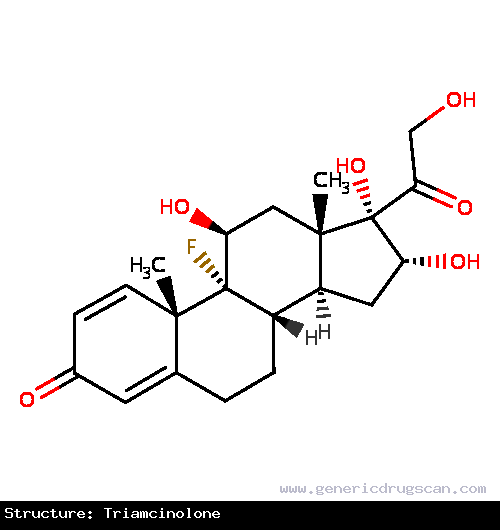Triamcinolone Drug: Indication, Dosage, Precaution, Side Effect , Storage, Category Type and corresponding Brands - www.genericdrugscan.com
Triamcinolone
Drug Status in USA : ApprovedDrug Status in Canada : Approved
pronunciation
pronounced as (trye am sin' oh lone)
Why is this medication prescribed?
Triamcinolone, a corticosteroid, is similar to a natural hormone produced by your adrenal glands. It often is used to replace this chemical when your body does not make enough of it. It relieves inflammation (swelling, heat, redness, and pain) and is used to treat certain forms of arthritis; skin, blood, kidney, eye, thyroid, and intestinal disorders (e.g., colitis); severe allergies; and asthma. Triamcinolone is also used to treat certain types of cancer.
This medication is sometimes prescribed for other uses; ask your doctor or pharmacist for more information.
How should this medicine be used?
Triamcinolone comes as a tablet and syrup to be taken by mouth. Your doctor will prescribe a dosing schedule that is best for you. Follow the directions on your prescription label carefully, and ask your doctor or pharmacist to explain any part you do not understand.
Do not stop taking triamcinolone without talking to your doctor. Stopping the drug abruptly can cause loss of appetite, upset stomach, vomiting, drowsiness, confusion, headache, fever, joint and muscle pain, peeling skin, and weight loss. If you take large doses for a long time, your doctor probably will decrease your dose gradually to allow your body to adjust before stopping the drug completely. Watch for these side effects if you are gradually decreasing your dose and after you stop taking the tablets or oral liquid, even if you switch to an inhalation. If these problems occur, call your doctor immediately. You may need to increase your dose of tablets or liquid temporarily or start taking them again.
Take triamcinolone exactly as directed. Do not take more or less of it or take it more often than prescribed by your doctor.
What are the precautions to be followed?
Before taking triamcinolone,- tell your doctor and pharmacist if you are allergic to triamcinolone, aspirin, tartrazine (a yellow dye in some processed foods and drugs), or any other drugs.
- tell your doctor and pharmacist what prescription and nonprescription medications you are taking, especially anticoagulants ('blood thinners') such as warfarin (Coumadin), arthritis medications, aspirin, cyclosporine (Neoral, Sandimmune), digoxin (Lanoxin), diuretics ('water pills'), estrogen (Premarin), ketoconazole (Nizoral), oral contraceptives, phenobarbital, phenytoin (Dilantin), rifampin (Rifadin), theophylline (Theo-Dur), and vitamins.
- if you have a fungal infection (other than on your skin), do not take triamcinolone without talking to your doctor.
- tell your doctor if you have or have ever had liver, kidney, intestinal, or heart disease; diabetes; an underactive thyroid gland; high blood pressure; mental illness; myasthenia gravis; osteoporosis; herpes eye infection; seizures; tuberculosis (TB); or ulcers.
- tell your doctor if you are pregnant, plan to become pregnant, or are breast-feeding. If you become pregnant while taking triamcinolone, call your doctor.
- if you are having surgery, including dental surgery, tell the doctor or dentist that you are taking triamcinolone.
- if you have a history of ulcers or take large doses of aspirin or other arthritis medication, limit your consumption of alcoholic beverages while taking this drug. Triamcinolone makes your stomach and intestines more susceptible to the irritating effects of alcohol, aspirin, and certain arthritis medications. This effect increases your risk of ulcers.
What are possible side effects of this medication ?
Triamcinolone may cause side effects. Tell your doctor if any of these symptoms are severe or do not go away:- upset stomach
- stomach irritation
- vomiting
- headache
- dizziness
- insomnia
- restlessness
- depression
- anxiety
- acne
- increased hair growth
- easy bruising
- irregular or absent menstrual periods
- skin rash
- swollen face, lower legs, or ankles
- vision problems
- cold or infection that lasts a long time
- muscle weakness
- black or tarry stool
How to store the medication and dispose it of after its use later?
Keep this medication in the container it came in, tightly closed, and out of reach of children. Store it at room temperature and away from excess heat and moisture (not in the bathroom).
Unneeded medications should be disposed of in special ways to ensure that pets, children, and other people cannot consume them. However, you should not flush this medication down the toilet. Instead, the best way to dispose of your medication is through a medicine take-back program.
Drug Category/Class
- Anti-Inflammatory Agents
- Glucocorticoids
- Corticosteroids for Local Oral Treatment
- Stomatological Preparations
- Alimentary Tract and Metabolism
- Corticosteroids
- Agents for Treatment of Hemorrhoids and Anal Fissures for Topical Use
- Vasoprotectives
- Corticosteroids, Moderately Potent (Group II)
- Corticosteroids, Plain
- Corticosteroids, Dermatological Preparations
- Corticosteroids for
| Prescribed | For the treatment of perennial and seasonal allergic rhinitis. |
| Weight : | 394.4339 |
| Structure | Triamcinolone |
 | |
| Formula | C21H27FO6 |
Triamcinolone has 36 Brands listed
Search Generic Drugs alphabetically
